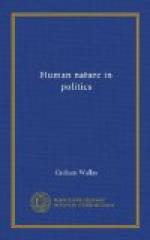But as a complete science of politics Benthamism is no longer possible. Pleasure and pain are indeed facts about human nature, but they are not the only facts which are important to the politician. The Benthamites, by straining the meaning of words, tried to classify such motives as instinctive impulse, ancient tradition, habit, or personal and racial idiosyncrasy as being forms of pleasure and pain. But they failed; and the search for a basis of valid political reasoning has to begin again, among a generation more conscious than were Bentham and his disciples of the complexity of the problem, and less confident of absolute success.
In that search one thing at least is becoming clear. We must aim at finding as many relevant and measurable facts about human nature as possible, and we must attempt to make all of them serviceable in political reasoning. In collecting, that is to say, the material for a political science, we must adopt the method of the biologist, who tries to discover how many common qualities can be observed and measured in a group of related beings, rather than that of the physicist, who constructs, or used to construct, a science out of a single quality common to the whole material world.
The facts when collected must, because they are many, be arranged. I believe that it would be found convenient by the political student to arrange them under three main heads: descriptive facts as to the human type; quantitative facts as to inherited variations from that type observed either in individuals or groups of individuals; and facts, both quantitative and descriptive, as to the environment into which men are born, and the observed effect of that environment upon their political actions and impulses.
A medical student already attempts to master as many as possible of those facts about the human type that are relevant to his science. The descriptive facts, for instance, of typical human anatomy alone which he has to learn before he can hope to pass his examinations must number many thousands. If he is to remember them so that he can use them in practice, they must be carefully arranged in associated groups. He may find, for instance, that he remembers the anatomical facts about the human eye most easily and correctly by associating them with their evolutionary history, or the facts about the bones of the hand by associating them with the visual image of a hand in an X-ray photograph.
The quantitative facts as to variations from the anatomical human type are collected for him in statistical form, and he makes an attempt to acquire the main facts as to hygienic environment when and if he takes the Diploma of Public Health.
The student teacher, too, during his period of training acquires a series of facts about the human type, though in his case they are as yet far less numerous, less accurate and less conveniently arranged than those in the medical text-books.




